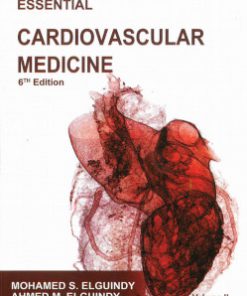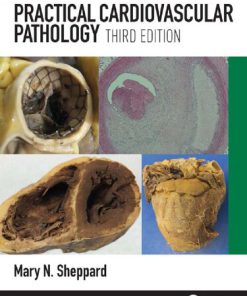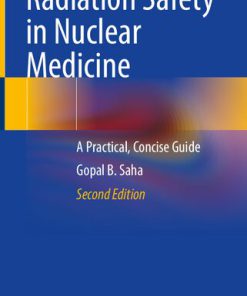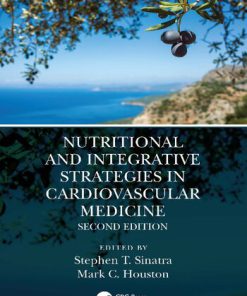Practical Cardiovascular Medicine 2nd Edition by Elias B Hanna ISBN 1119832705 9781119832706
$50.00 Original price was: $50.00.$25.00Current price is: $25.00.
Practical Cardiovascular Medicine 2nd Edition by Elias B Hanna – Ebook PDF Instant Download/Delivery: 1119832705 ,9781119832706
Full download Practical Cardiovascular Medicine 2nd Edition after payment

Product details:
ISBN 10: 1119832705
ISBN 13: 9781119832706
Author: Elias B Hanna
Providing a complete but succinct overview of the information cardiologists and cardiology trainees need to have at their fingertips, Practical Cardiovascular Medicine, Second Edition is an everyday primary guide to the specialty.
- Provides cardiologists with a thorough and up-to-date review of cardiology, from pathophysiology to practical, evidence-based management
- Ably synthesizes pathophysiology fundamentals and evidence-based approaches to prepare a physician for a subspecialty career in cardiology
- Clinical chapters cover coronary artery disease, heart failure, arrhythmias, valvular disorders, pericardial disorders, congenital heart disease, and peripheral arterial disease
- Practical chapters address ECG, coronary angiography, catheterization techniques, echocardiography, hemodynamics, and electrophysiological testing
- Includes over 730 figures, key notes boxes, references for further study, and coverage of clinical trials
- Review questions help clarify topics and can be used for Board preparation – over 650 questions in all
The Second Edition has been comprehensively updated with the newest data and with both the American and European guidelines. More specifically, 20 clinical chapters have been rewritten and extensively revised. Procedural chapters have been enhanced with additional concepts and illustrations, particularly the hemodynamic and catheterization chapters. Clinical questions have been revamped, new questions have been added, including a new, 259-question section at the end of the book.
Practical Cardiovascular Medicine, Second Edition is an ideal reference for the resident, fellow, cardiologist, and any professional treating patients with cardiovascular disease
Practical Cardiovascular Medicine 2nd Edition Table of contents:
Part 1: CORONARY ARTERY DISEASE
1 Non-ST-Segment Elevation Acute Coronary Syndrome
Appendix 1. Complex angiographic disease- Moderate disease progression
Appendix 2. Women and ACS, elderly patients and ACS, CKD
Appendix 3. Bleeding, transfusion, patients on chronic warfarin or NOAC, gastrointestinal bleed
Appendix 4. Antiplatelet and anticoagulant therapy
Appendix 5. Difference between plaque rupture and plaque erosion
Appendix 6. Spontaneous coronary artery dissection
Appendix 7. Harmful effects of NSAIDs and cyclooxygenase-2 inhibitors in CAD
Appendix 8. Additional ideas on the physiology of hs-troponin-Role of hs-troponin in primary prevention
QUESTIONS AND ANSWERS
References
2 ST-Segment Elevation Myocardial Infarction
1. DEFINITION, REPERFUSION, AND GENERAL MANAGEMENT
2. STEMI COMPLICATIONS
Appendix 1. Out-of-hospital cardiac arrest: role of early coronary angiography and therapeutic hypothermia
QUESTIONS AND ANSWERS
References
Other acute therapies
Early discharge
Prognosis
ICD
Shock (+ SHOCK trial and CULPRIT-SHOCK trial, references 69 and 73)
RV shock (+ reference 89 above)
Mechanical complications
Arrhythmias
Aneurysm and pseudo-aneurysm
Post-MI pericarditis
LV thrombus
Prognosis
Cardiac arrest
Note
3 Stable Ischemic Heart Disease and Approach to Chronic Chest Pain
Appendix 1. Notes on various surgical grafts
Appendix 2. Coronary vasospasm (variant angina, Prinzmetal angina)
Appendix 3. Microvascular endothelial dysfunction
Appendix 4. Women with chest pain and normal coronary arteries
Appendix 5. Diagnostic strategy for ischemia with non-obstructed coronary arteries (INOCA)
Appendix 6. Myocardial bridging
Appendix 7. Coronary collaterals, chronic total occlusion
Appendix 8. Hibernation, stunning, ischemic preconditioning
QUESTIONS AND ANSWERS
References
Part 2: HEART FAILURE (CHRONIC AND ACUTE HEART FAILURE, SPECIFIC CARDIOMYOPATHIES, AND PATHOPHYSIOLOGY)
4 Heart Failure
DEFINITION, TYPES, CAUSES, AND DIAGNOSIS OF HEART FAILURE
1. DEFINITION AND TYPES OF HEART FAILURE
I. Heart failure is diagnosed clinically, not by echocardiography
II. After HF is defined clinically, echocardiography is used to differentiate the three major types of HF
2. CAUSES OF HEART FAILURE
I. Systolic HF or HF with reduced EF (HFrEF)
II. HF with preserved EF (HFpEF)
III. Right HF
3. DIAGNOSTIC TESTS
I. Echocardiography
II. BNP
III. ECG
IV. Coronary angiography and other ischemic tests
V. Diastolic stress testing
VI. Endomyocardial biopsy
VII. Cardiac MRI
CHRONIC TREATMENT OF HEART FAILURE
1. TREATMENT OF SYSTOLIC HEART FAILURE
I. Treat the underlying etiology: target BP and CAD
II. Value of revascularization in ischemic cardiomyopathy: STICH trial
III. Role of viability testing and ischemic testing
IV. Drugs that affect survival in EF<40%
V. Specifics of drugs that affect survival
VI. Drugs that improve symptoms and morbidity
VII. Devices
VIII. Other therapeutic measures
IX. Prognosis
2. TREATMENT OF HFPEF
ACUTE HEART FAILURE AND ACUTELY DECOMPENSATED HEART FAILURE
I. Triggers of acute decompensation
II. Profiles of acute HF: congestion without low cardiac output, congestion with low cardiac output
III. Treatment of acute HF: diagnosis and treatment of triggers
IV. Treatment of acute HF: diuretics, cardiorenal syndrome, aggressive decongestion, ultrafiltration
V. Treatment of acute HF: vasodilators
VI. Treatment of acute HF: IV inotropic agents
VII. In-hospital and pre-discharge use of ACE-I/ARB, angiotensin-neprilysin inhibition, and β-blockers
VIII. Treatment of acute HF: O2, non-invasive ventilatory support (CPAP, BiPAP), intubation
IX. Summary: keys to the treatment of acute HF (Table 4.2)
X. Discharge
XI. Inability of severe HF to tolerate vasodilatation or hemodialysis
XII. Outpatient monitoring of HF and prevention of hospitalization
Appendix 1. Management of isolated or predominant RV failure
QUESTIONS AND ANSWERS
References
Diuretics
5 Additional Heart Failure Topics
1. SPECIFIC CARDIOMYOPATHIES
2. ADVANCED HEART FAILURE: HEART TRANSPLANT AND VENTRICULAR ASSIST DEVICES (VADs)
3. PATHOPHYSIOLOGY OF HEART FAILURE AND HEMODYNAMIC ASPECTS
QUESTIONS AND ANSWERS
References
Part 3: VALVULAR DISORDERS
6 Valvular Disorders
1. MITRAL REGURGITATION
2. MITRAL STENOSIS
3. AORTIC INSUFFICIENCY
4. AORTIC STENOSIS
5. TRICUSPID REGURGITATION AND STENOSIS
6. PULMONIC STENOSIS AND REGURGITATION
7. MIXED VALVULAR DISEASE; RADIATION HEART DISEASE
8. PROSTHETIC VALVES
9. AUSCULTATION AND SUMMARY IDEAS
QUESTIONS AND ANSWERS
References
Part 4: HYPERTROPHIC CARDIOMYOPATHY
7 Hypertrophic Cardiomyopathy
QUESTIONS AND ANSWERS
References
Part 5: ARRHYTHMIAS AND ELECTROPHYSIOLOGY
8 Approach to Narrow and Wide QRS Complex Tachyarrhythmias
Further reading
9 Ventricular Arrhythmias
QUESTIONS AND ANSWERS
References
10 Atrial Fibrillation
I. Predisposing factors (see Table 10.1)
II. Types of AF
III. General therapy of AF
IV. Management of a patient who presents with acute, symptomatic AF
V. Peri-cardioversion anticoagulation management
VI. Antiarrhythmic management after the acute presentation
VII. Decisions about long-term anticoagulation, role of clopidogrel, role of triple therapy
VIII. Special situation: atrial fibrillation and heart failure. Optimal heart rate in heart failure
IX. Special situation: atrial fibrillation with borderline blood pressure or non-AF-related hypotension
X. AF burden as a correlate and a driver of HF progression
Appendix 1. Optimal heart rate and AF rate for optimal cardiac output
Appendix 2. Antiarrhythmic drug therapy
Appendix 3. Catheter ablation of atrial fibrillation, surgical ablation, AV nodal ablation
Appendix 4. INR follow-up in patients receiving warfarin-Non-vitamin K oral anticoagulants
Appendix 5. Bridging anticoagulation in patients undergoing procedures
Appendix 6. Management of elevated INR values
Appendix 7. Left atrial appendage surgical and percutaneous closure
Appendix 8. A common situation: AF and symptomatic pauses or bradycardia
Appendix 9. DC cardioversion in patients with a slow ventricular response
Appendix 10. AF occurring post-cardiac surgery and AF related to acute transient triggers
Appendix 11. Brief asymptomatic runs of AF on device interrogation and association with stroke. Role of rhythm monitoring after cryptogenic stroke
QUESTIONS AND ANSWERS
References
11 Atrial Flutter and Atrial Tachycardia
I. Atrial flutter
II. Focal atrial tachycardia
III. Multifocal atrial tachycardia (MAT) (or chaotic atrial tachycardia)
IV. Ectopic atrial rhythm
QUESTIONS AND ANSWERS
References
Further reading
12 Atrioventricular Nodal Reentrant Tachycardia, Atrioventricular Reciprocating Tachycardia, Wolff–Parkinson–White Syndrome, and Junctional Rhythms
QUESTIONS AND ANSWERS
Further reading
13 Bradyarrhythmias
QUESTIONS AND ANSWERS
References
14 Permanent Pacemaker and Implantable Cardioverter Defibrillator
Appendix. Cases of PM troubleshooting
QUESTIONS AND ANSWERS
References
Note
15 Basic Electrophysiologic Study
I. General concepts; intracardiac electrograms
II. AV conduction abnormalities
III. Sinus node assessment
IV. Ventricular vs. supraventricular tachycardia
V. Dual AV nodal pathways
VI. AVNRT
VII. Accessory pathway, orthodromic AVRT, antidromic AVRT
VIII. Atrial flutter
IX. Inducible VT
X. Mapping for ablation
XI. EP electro-anatomical mapping
Further reading
16 Action Potential Features and Propagation
I. Action potential (see Figures 16.1, 16.2)
II. Action potential propagation and mechanisms of arrhythmias
III. General mechanism of action of antiarrhythmic agents
IV. Modulated receptor hypothesis and use dependence
V. Concept of concealed conduction
VI. Specific examples of drugs (see also Chapter 10)
VII. Amiodarone toxicity
VIII. Effect on pacing thresholds and defibrillation thresholds
Further reading
Part 6: PERICARDIAL DISORDERS
17 Pericardial Disorders
1. ACUTE PERICARDITIS
2. TAMPONADE
3. PERICARDIAL EFFUSION
4. CONSTRICTIVE PERICARDITIS
QUESTIONS AND ANSWERS
References
Further reading
Part 7: CONGENITAL HEART DISEASE
Chapter 18: Congenital Heart Disease
1. ACYANOTIC CONGENITAL HEART DISEASE
2. CYANOTIC CONGENITAL HEART DISEASE
3. MORE COMPLEX CYANOTIC CONGENITAL HEART DISEASE AND SHUNT PROCEDURES
QUESTIONS AND ANSWERS
References
Part 8: PERIPHERAL ARTERIAL DISEASE
19 Peripheral Arterial Disease
1. LOWER EXTREMITY PERIPHERAL ARTERIAL DISEASE
I. Clinical tips
II. Clinical classification of PAD – Critical limb ischemia, acute limb ischemia, atheroembolization
III. Diagnosis of PAD
IV. Medical therapy of PAD
V. Revascularization for PAD
VI. Notes on the technical aspects of surgical and percutaneous therapies
VII. Management of acute limb ischemia
VIII. Management of lower extremity ulcers (Table 19.6)
2. CAROTID DISEASE
I. Assessment of carotid stenosis
II. Medical therapy of carotid stenosis
III. Revascularization of asymptomatic carotid stenosis
IV. Revascularization of symptomatic carotid stenosis
V. Main risks of CEA and carotid stenting
VI. CEA versus carotid stenting
VII. Carotid disease in a patient undergoing CABG
VIII. Subtotal and total carotid occlusions
3. RENAL ARTERY STENOSIS
I. Forms of renal artery stenosis
II. Screening and indications to revascularize renal artery stenosis
III. Notes
QUESTIONS AND ANSWERS
References
20 Aortic Diseases
I. Aortic dissection
II. Thoracic aortic aneurysm
III. Abdominal aortic aneurysm
References
Part 9: OTHER CARDIOVASCULAR DISEASE STATES
21 Pulmonary Embolism and Deep Vein Thrombosis
1. PULMONARY EMBOLISM
I. Presentation of pulmonary embolism (PE) and risk factors
II. Probability of PE
III. Initial workup
IV. Specific PE workup
V. Submassive or intermediate-high risk PE, pulmonary hypertension, and thrombolysis
VI. PE and chronic pulmonary hypertension
VII. Acute treatment of PE
VIII. Duration of anticoagulation
IX. Thrombophilias
X. PE prognosis and long-term follow-up
2. DEEP VEIN THROMBOSIS
I. Types
II. Diagnosis
III. Treatment
3. IMMUNE HEPARIN-INDUCED THROMBOCYTOPENIA
I. Incidence
II. Diagnosis
III. Treatment
QUESTIONS AND ANSWERS
References
22 Shock and Fluid Responsiveness
1. SHOCK
I. Shock definition and mechanisms
II. Goals of shock treatment
III. Immediate management of any shock
IV. Sepsis and septic shock
V. Cardiogenic shock
2. FLUID RESPONSIVENESS
Appendix. Hemodynamic equations, transfusion, and miscellaneous concepts
QUESTIONS AND ANSWERS
References
Note
23 Hypertension
1. HYPERTENSION
I. Definition
II. ACC and ESC targets of therapy and rationale
III. Treatment of hypertension: timing, first-line drugs, compelling indications for specific drugs
IV. Resistant hypertension
V. Secondary hypertension
VI. Peripheral vs. central aortic pressure: therapeutic implications
VII. First-line antihypertensive drugs
VIII. Second-line antihypertensive drugs
IX. Orthostatic hypotension and extremely labile HTN
2. ACUTE SEVERE HYPERTENSION: HYPERTENSIVE EMERGENCIES AND URGENCIES
I. Definitions
II. Treatment of hypertensive emergencies
III. Treatment of hypertensive urgencies
IV. Specific situations (see Table 23.5)
QUESTIONS AND ANSWERS
References
24 Dyslipidemia
I. Indications for therapy
II. Notes on LDL, HDL, and triglycerides
III. Drugs: LDL-lowering drugs
IV. Drugs: TG/HDL-treating drugs and lifestyle modification
V. Metabolic syndrome
VI. Diabetes and cardioprotective diabetic drugs
VII. Elevated hs-CRP (high-sensitivity C-reactive protein test) ≥2 mg/l
VIII. Chronic kidney disease (CKD)
IX. Causes of dyslipidemia to consider
X. Side effects of specific drugs: muscle and liver intolerance with statins, fibrates, and niacin
XI. Aspirin is ineffective in primary prevention
QUESTIONS AND ANSWERS
References
25 Pulmonary Hypertension
I. Definition
II. Categories of PH
III. Two tips in the evaluation of PH
IV. Hypoxemia in patients with PH
V. Diagnosis: echocardiography; right and left heart catheterization
VI. Treatment
QUESTIONS AND ANSWERS
References
26 Syncope
I. Neurally mediated syncope (reflex syncope)
II. Orthostatic hypotension and postural orthostatic tachycardia syndrome
III. Cardiac syncope
IV. Other causes of syncope
V. Syncope mimic: seizure (see Table 26.1)
VI. Clinical clues (see Table 26.2)
VII. Diagnostic evaluation of syncope ( Figure 26.1 )
VIII. Tilt table testing (see Table 26.4)10, 40
IX. Indications for hospitalization
X. Treatment of vasovagal syncope, orthostatic hypotension, and POTS
QUESTIONS AND ANSWERS
References
27 Chest Pain, Dyspnea, Palpitations
1. CHEST PAIN
I. Causes (see Table 27.1)
II. Features
III. Management of chronic chest pain
IV. Management of acute chest pain
2. ACUTE DYSPNEA
I. Causes (see Table 27.2)
II. Notes
III. Management
3. PALPITATIONS
I. Causes
II. Diagnosis
References
28 Infective Endocarditis and Cardiac Rhythm Device Infections
1. INFECTIVE ENDOCARDITIS
I. Clinical diagnosis
II. Echocardiography: timing and indications
III. Organisms
IV. Morphology
V. Anatomical complications
VI. Indications for valvular surgery and special situations
2. CARDIAC RHYTHM DEVICE INFECTIONS
I. Organisms and mechanisms of infection
II. Diagnosis
III. Diagnosis in patients with bacteremia but no local or TEE signs of infection
IV. Management
References
29 Preoperative Cardiac Evaluation
I. Steps in preoperative evaluation
II. Surgical risk: surgery’s risk and patient’s risk
III. CARP and DECREASE V trials
IV. Only the highest-risk coronary patients require revascularization preoperatively
V. Preoperative percutaneous revascularization
VI. Surgery that needs to be performed soon after stent placement
VII. Preoperative β-blocker therapy
VIII. Other interventions that improve outcomes
IX. Severe valvular disease
X. Perioperative hypertension
XI. Preoperative management of patients with pacemakers or ICDs
QUESTIONS AND ANSWERS
References
30 Miscellaneous Cardiac Topics
1. CARDIAC MASSES
I. Differential diagnosis of a cardiac mass
II. Cardiac tumors; focus on atrial myxoma
2. PREGNANCY AND HEART DISEASE
I. High-risk cardiac conditions during which pregnancy is better avoided 9
II. Cardiac conditions that are usually well tolerated during pregnancy, but in which careful cardiac evaluation and clinical and echo follow-up are warranted 9
III. Cardiac indications for cesarean section
IV. Mechanical prosthetic valves in pregnancy: anticoagulation management
V. Peripartum cardiomyopathy (PPCM)
VI. Cardiovascular drugs during pregnancy (see Table 30.2)
VII. Arrhythmias during pregnancy
VIII. MI and pregnancy
IX. Hypertension and pregnancy
3. HIV AND HEART DISEASE
I. Pericardial disease
II. HIV cardiomyopathy
III. Pulmonary hypertension (PH)
IV. CAD
4. COCAINE AND THE HEART
I. Myocardial ischemia
II. Other cardiac complications of cocaine
5. CHEMOTHERAPY AND HEART DISEASE
I. Cardiomyopathy
II. Myocardial ischemia
III. Atrial fibrillation
6. CHEST X-RAY
I. Chest X-ray in heart failure (see Figures 30.2, 30.3)
II. Various forms of cardiomegaly (see Figure 30.4)
III. Left atrial enlargement; aortic dilatation
IV. Lateral chest X-ray
V. Chest X-ray in congenital heart disease
QUESTIONS AND ANSWERS
References
Part 10: CARDIAC TESTS: ELECTROCARDIOGRAPHY, ECHOCARDIOGRAPHY, AND STRESS TESTING
31 Electrocardiography
I. Overview of ECG leads and QRS morphology
II. Stepwise approach to ECG interpretation
III. Rhythm and rate
IV. QRS axis in the limb leads and normal QRS progression in the precordial leads
V. P wave: analyze P wave in leads II and V1 for atrial enlargement, and analyze PR interval (see Figures 31.18, 31.19)
VI. Height of QRS: LVH, RVH
VII. Width of QRS. Conduction abnormalities: bundle brunch blocks
VIII. Conduction abnormalities: fascicular blocks
IX. Low QRS voltage and electrical alternans
X. Assessment of ischemia and infarction: Q waves
XI. Assessment of ischemia: ST-segment depression and T-wave inversion
XII. Assessment of ischemia: differential diagnosis of ST-segment elevation
XIII. Assessment of ischemia: large or tall T wave
XIV. QT analysis and U wave
XV. Electrolyte abnormalities, digitalis effect and digitalis toxicity, hypothermia, PE, poor precordial R-wave progression
XVI. Approach to tachyarrhythmias
XVII. Approach to bradyarrhythmias: AV block
XVIII. Abnormal automatic rhythms that are not tachycardic
XIX. Electrode misplacement
Appendix 1. Supplement on STEMI and Q‐wave MI: phases and localization
Appendix 2. Spread of electrical depolarization in various disease states using vector illustration ( Figures 31.100 – 31.103 )
QUESTIONS AND ANSWERS
References
Further reading
32 Echocardiography
1. GENERAL ECHOCARDIOGRAPHY
I. The five major echocardiographic views and the myocardial wall segments
II. Global echo assessment of cardiac function and structure
III. Doppler and assessment of valvular regurgitation and stenosis
IV. Summary of features characterizing severe valvular regurgitation and stenosis (see Tables 32.1, 32.2)
V. M-mode echocardiography
VI. Pericardial effusion
VII. Echocardiographic determination of LV filling pressure and diastolic function
VIII. Additional echocardiographic hemodynamics
IX. Prosthetic valves
X. Brief note on Doppler physics and echo artifacts
2. TRANSESOPHAGEAL ECHOCARDIOGRAPHY (TEE) VIEWS
Appendix. Note on LV mechanics and myocardial tissue strain
Further reading
33 Stress Testing, Nuclear Imaging, Coronary CT Angiography, Cardiac MRI, Cardiopulmonary Exercise Testing
I. Indications for stress testing
II. Contraindications to all stress testing modalities
III. Stress testing modalities
IV. Diagnostic yields and pitfalls of stress ECG and stress imaging
V. Mechanisms of various stress modalities
VI. Nuclear stress imaging (see Figures 33.3, 33.4, 33.5)
VII. Coronary CT angiography and coronary calcium scoring
VIII.Cardiac MRI: summary of applications and findings
IX.Cardiopulmonary exercise testing (CPET)
References
Part 11: CARDIAC TESTS: INVASIVE CORONARY AND CARDIAC PROCEDURES
34 Angiographic Views: Coronary Arteries and Grafts, Left Ventricle, Aorta, Coronary Anomalies, Peripheral Arteries, Carotid Arteries
I. Right coronary artery
II. Left coronary artery
III. Coronary angiography views. Recognize the angle of a view: LAO vs. RAO, cranial vs. caudal
IV. Coronary angiography views. General ideas: cranial vs. caudal views
V. Coronary angiography views. General ideas: foreshortening and identifying branches
VI. Left coronary views (see Figure 34.8)
VII. Right coronary views
VIII. Improve the angiographic view in case of vessel overlap or foreshortening: effects of changing the angulation, effects of respiration, and vertical vs. horizontal heart
IX. Saphenous venous graft views
X. LIMA-to-LAD or LIMA-to-diagonal views
XI. Left ventriculography
XII. Aortography for assessment of aortic insufficiency
XIII. Coronary anomalies
XIV. Lower extremity angiography
XV. Carotid angiography
QUESTIONS AND ANSWERS
Further reading
35 Cardiac Catheterization Techniques, Tips, and Tricks
I. View for the engagement of the native coronary arteries: RAO vs. LAO
II. Design of the Judkins and Amplatz catheters (see Figures 35.2–35.7)
III. Engagement of the RCA (see Figure 35.8)
IV. How to gauge the level of the RCA origin in relation to the aortic valve level
V. What is the most common cause of failure to engage the RCA? What is the next step?
VI. Tiger or JR4 catheter engages the conus branch. What is the next step?
VII. Left coronary artery engagement: general tips
VIII. Management of a JL catheter that is sub-selectively engaged in the LAD or LCx
IX. Specific maneuvers for the Amplatz left catheter
X. If you feel that no torque is getting transmitted, what is the next step?
XI. Appropriate guide catheters for left coronary interventions
XII. Appropriate guide catheters for RCA interventions (Figure 35.20)
XIII. Selective engagement of SVGs: general tips
XIV. Specific torque maneuvers for engaging the SVGs
XV. Appropriate catheters for engaging SVGs (see Figure 35.24)
XVI. Engagement of the left internal mammary artery graft
XVII. Left ventricular catheterization
XVIII. Engagement of anomalous coronary arteries
XIX. Specific tips for coronary engagement using a radial approach
XX. Damping and ventricularization of the aortic waveform upon coronary engagement, and role of side-hole catheters
XXI. Technique of right heart catheterization
36 Hemodynamics
I. Right heart catheter (see Figure 36.1)
II. Overview of pressure tracings: differences between atrial, ventricular, and arterial tracings (Figures 36.2, 36.3, 36.4)
III. RA pressure abnormalities
IV. Pulmonary capillary wedge pressure (PCWP) abnormalities
V. LVEDP
VI. Cardiac output and vascular resistances
VII. Shunt evaluation
VIII. Valvular disorders: overview of pressure gradients and valve area calculation
IX. Dynamic LVOT obstruction
X. Pericardial disorders: tamponade and constrictive pericarditis (see Figures 36.23, 36.24)
XI. Exercise hemodynamics
XII.Additional hemodynamic caveats in AF
Appendix 1. Advanced hemodynamic calculation: a case of shunt with pulmonary hypertension
QUESTIONS AND ANSWERS: ADDITIONAL HEMODYNAMIC CASES
References
Suggested reading:
37 Intracoronary Imaging
1. INTRAVASCULAR ULTRASOUND (IVUS)
I. Image basics
II. Plaque types
III. Basic IVUS measurements
IV. Interpretation of how a severe stenosis may look mild angiographically, yet severe by IVUS; significance of lesion haziness (see Figure 37.16)
V. Endpoints of stenting
VI. Assessment of lesion significance by IVUS
VII. Assessment of left main by IVUS
2. OPTICAL COHERENCE TOMOGRAPHY (OCT)
References
Further reading
38 Percutaneous Coronary Interventions and Complications, Intra-Aortic Balloon Pump, Ventricular Assist Devices, and Fractional Flow Reserve
I. Major coronary interventional devices
II. Stent thrombosis, restenosis, and neoatherosclerosis
III. Peri-PCI antithrombotic therapy (see Table 38.3)
IV. Complex lesion subsets
V. Sheath management
VI. Post-PCI mortality and coronary complications
VII. Femoral access complications
VIII. Renal, stroke, and atheroembolic complications
IX. Intra-aortic balloon pump (IABP) or intra-aortic balloon counterpulsation
X. Percutaneous LV assist device: Impella and TandemHeart
XI. Extracorporeal membrane oxygenation (ECMO)
XII. Fractional flow reserve (FFR)
QUESTIONS AND ANSWERS
Further reading
Appendix Appendix General review questions
QUESTIONS
I. NSTEMI and STEMI (Answers on pages 901–903)
II. Stable CAD (Answers on pages 903–905)
III. Heart failure and cardiomyopathies (Answers on pages 905–909)
IV. Valvular disorders (Answers on pages 909–913)
V. Arrhythmias (Answers on pages 913–916)
VI. Congenital heart disease (Answers on pages 916–918)
VII. Peripheral arterial disease- Pulmonary embolism-Pulmonary hypertension (Answers on pages 918–919)
VIII. Hypertension and syncope (Answers on pages 919–920)
IX. Pregnancy-Chemotherapy and heart disease- Miscellaneous (Answers on pages 920–921)
X. ECG (Answers on pages 921, 922)
XI. Echocardiography (Answers on pages 923, 924)
XII. Additional hemodynamics (Answers on page 925)
XIII. Percutaneous coronary intervention and shock (Answers on pages 926–929)
XIV. Radiation in the cardiac catheterization laboratory (Answers on pages 929, 930)
ANSWERS
I. NSTEMI and STEMI
II. Stable CAD
III. Heart failure and cardiomyopathies
IV. Valvular disorders
V. Arrhythmias
VI. Congenital heart disease
VII. Peripheral arterial disease- Pulmonary embolism-Pulmonary hypertension
VIII. Hypertension and syncope
IX. Pregnancy-Chemotherapy and heart disease- Miscellaneous
X. ECG
XI. Echocardiography
XII. Additional hemodynamics
XIII. Percutaneous coronary intervention and shock
XIV. Radiation in the cardiac catheterization laboratory
Index
People also search for Practical Cardiovascular Medicine 2nd Edition:
borrow practical cardiovascular medicine
practical cardiovascular medicine 2nd edition pdf
practical cardiovascular medicine latest edition
practical cardiovascular medicine elias
practical cardiovascular medicine second edition
Tags: Elias B Hanna, Practical Cardiovascular Medicine
You may also like…
Medicine - Cardiology
Essential Cardiovascular Medicine 6th Edition Volume 2 Mohamed S. Elguindy
Medicine - Anatomy and physiology
Practical Cardiovascular Pathology 3rd Edition by Mary Sheppard ISBN 9781498787550 149878755X
Medicine - Others
Radiation Safety in Nuclear Medicine A Practical Concise Guide 2nd Edition Gopal B. Saha
Uncategorized
Arts - Contemporary Art
Landscape 1 Institute for Land and Environmental Art Hanna B. Hölling
Animals & Pets - Animal Care & Pets
Textbook of Cardiovascular Medicine in dogs and cats 1st Edition Bussadori
Medicine - Cardiology
Manual of Cardiovascular Medicine 1st Edition Thomas Lüscher (Editor)
Medicine - Health-Related Professions











